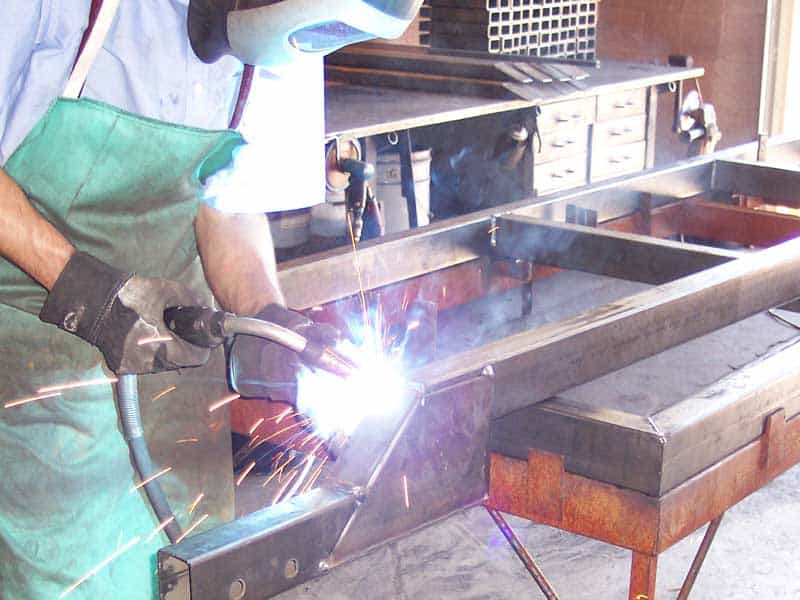Whether you’re an enthusiastic at-home mechanic or someone who’s just looking to patch up some unsightly cracks in your car, welding is a useful skill to have. It can help you make customizations to your vehicle if you want to personalize it. Plus, if you damage the body, you won’t have to go to the body shop and pay through the nose for repairs.
Welding on a car requires different skills than regular welding. Plus, you have to be careful not to disrupt the electronics involved in making your car run. Taking precautions such as grounding your equipment and following the right steps is important to welding on a car.
Before you start repairing your own chariot, read this detailed guide.
Table of Contents
Can You Weld on a Car?
Yes, you can weld on a car. Welding is actually an integral part of car manufacturing. That is how the metal pieces are created, from the frame to the doors. Car welding is a very lucrative career, as many factories are looking for qualified welders. If you want to weld professionally, this is one niche to explore.
You can weld on a car even if you’re just a hobbyist welder. However, welding on a car is harder than welding a table together or another simple project. The pieces are more complicated. If you make a mistake, the consequences are a lot bigger (especially if you decided to “fix” the family car on your own without telling your spouse). Finally, you can cause a lot more damage to the electrical parts.
So, the answer to if you can weld on a car is yes, but you have to be careful. If you’re a beginner welder, it’s probably better to start off with some simpler projects first.

How to Protect Your Electronics When Welding on A Car
One of the biggest dangers when welding on a car is that you will damage your electronics. This applies to your radio and stereo system and to the all-important computers that make up an Engine Control Unit (ECU). Metal conducts electricity, so when you weld, the electricity flows into your car’s electronics and damages it.
Before you start welding, you need to take precautions so you don’t permanently fry your ECU. First, look at the battery and locate two red or black packs terminals. Take out the negative one with a screwdriver and replace it when you’re done.
Then, make that you ground the metal you are welding. That way, electricity will flow into the soil instead of through your car and into the very sensitive computer systems.
Legal Requirements for Welding on a Car
There is no law preventing you from welding on a car. However, laws of the road can prevent you from taking your creation into traffic.
You have to be very careful when welding a car frame. The Federal Motor Carrier Safety Administration states that frames cannot sag, the flanges cannot be damaged, and nothing can be welded to the frame. Cut-and-shuts, or welding the frames from two damaged autos together, are also illegal in most places.
When welding automobiles, make sure that the parts you have are legit because if you are caught welding off the Vehicle Identification Number (VIN) or using parts from a stolen car, you could get in big trouble.
These are just federal laws. States and municipalities have their own laws regarding welding cars, so double-check first. If you’re messing around for a hobby, you should be fine, but double-check before taking your creation on the road.
Types of Welding for a Car
There are many types of welding that you can use on a car, including:
1. Tungsten Inert Gas (TIG) Welding
This form of welding is great for advanced welders who are conducting very delicate repairs. It uses a fixed tungsten electrode and a filler metal to weld metals together.
2. Metal Inert Gas (MIG) Welding
MIG welding uses a disposable wire filler and a shield gas to weld. MIG welding is great for beginners because you only need one hand to operate the welding machine, so you can use the other hand to hold materials in place or make other repairs. MIG welding is extremely versatile in terms of materials, thickness, and job size, making it perfect for nearly any work, including auto-body work.
3. Plasma Arc Welding (PAW)
Plasma arc welding is another form of welding that uses a tungsten electrode, like TIG welding. The electrode forms a plasma arc between the welding gun and the base material. This is more common in commercial settings because DIY welders don’t have much access to plasma welding machines.
Equipment Required
To start working on your car, you need a lot of equipment. Here is what your workshop should have:
- A welding machine
- Electrodes or filler wire
- Angle grinder to smooth out welds
- Pneumatic saw to cut metal and line it up into place
- Locking clamps to hold materials in place
- Body hammers to even out the metal around your repair patch
- Sheet metal gauge to make sure you’re using the right MIG size for your patch
- Safety equipment such as a welding helmet and gloves
Tips and Tricks
Auto welding is complicated because there is so much room for error. If you don’t have much welding experience, practice on some scrap metal, making similar welds you will use on a car.
Make sure to set up your work area properly, including cutting patches in place, sizing the right gauge, grounding your equipment, and putting all your supplies within reach. Some preparation can save you a lot of stress once you turn on the welding machine.
Final Thoughts
Once you are confident with your welding skills, you can weld on a car and save yourself a trip to the body shop. However, be careful not to damage the electrical systems and follow legal requirements when working on the frame.
